


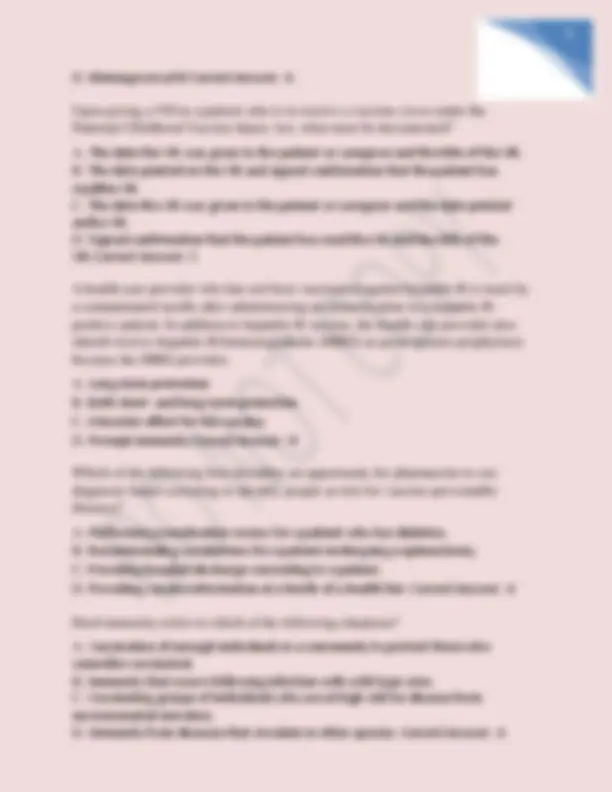

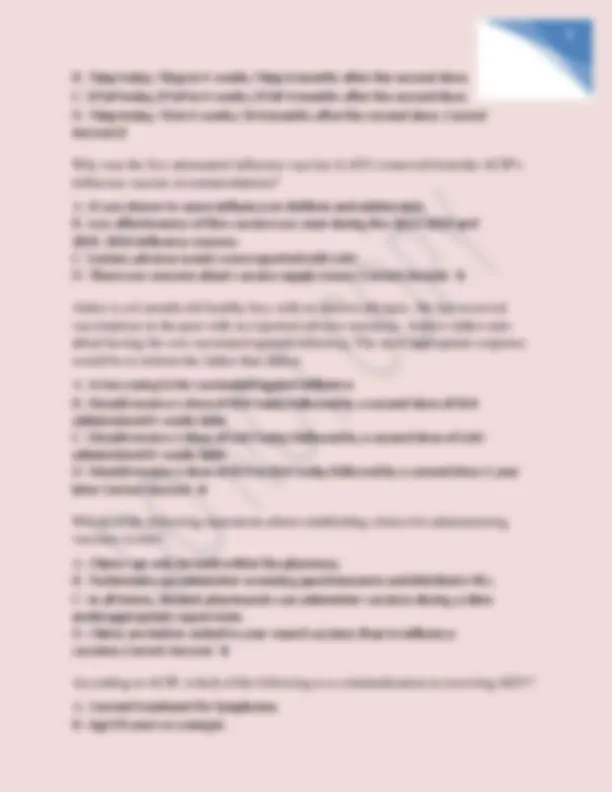

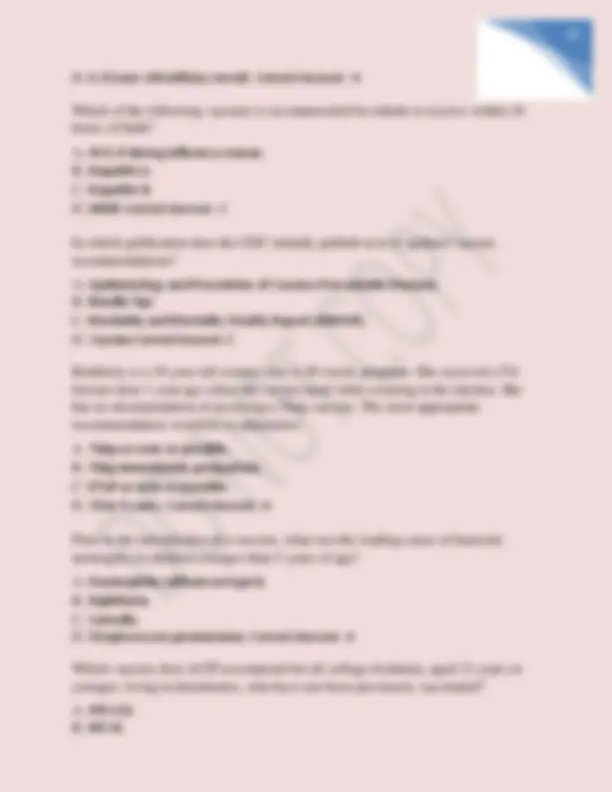

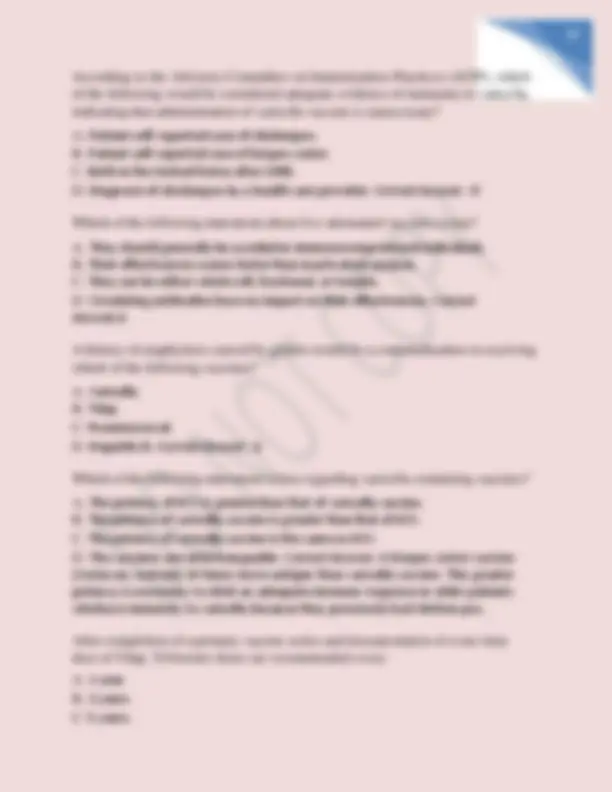

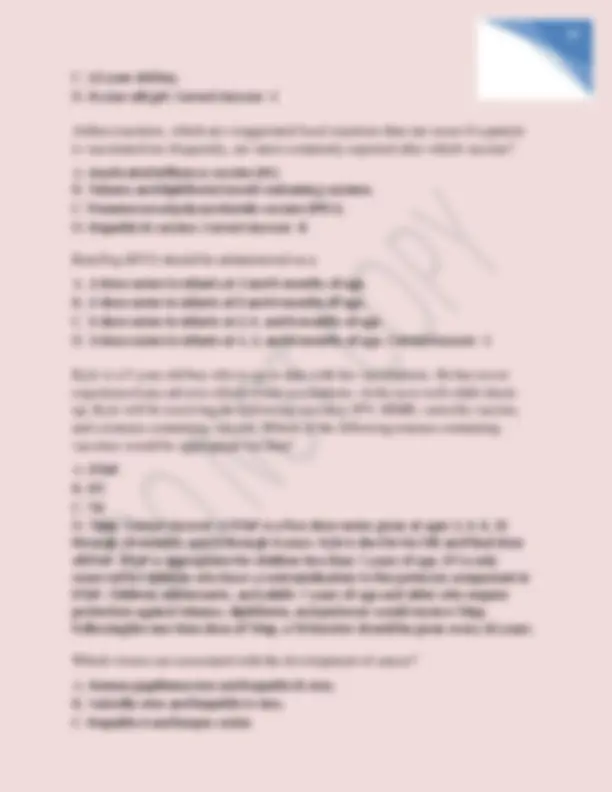

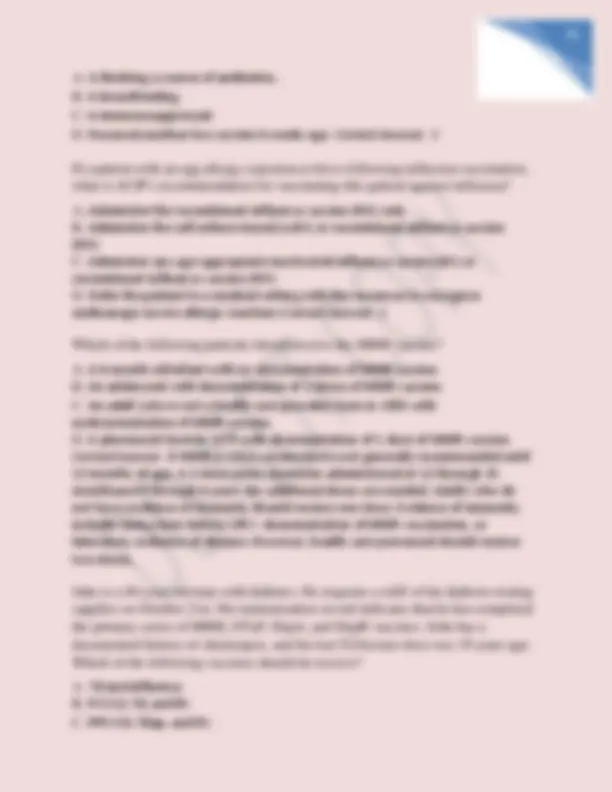


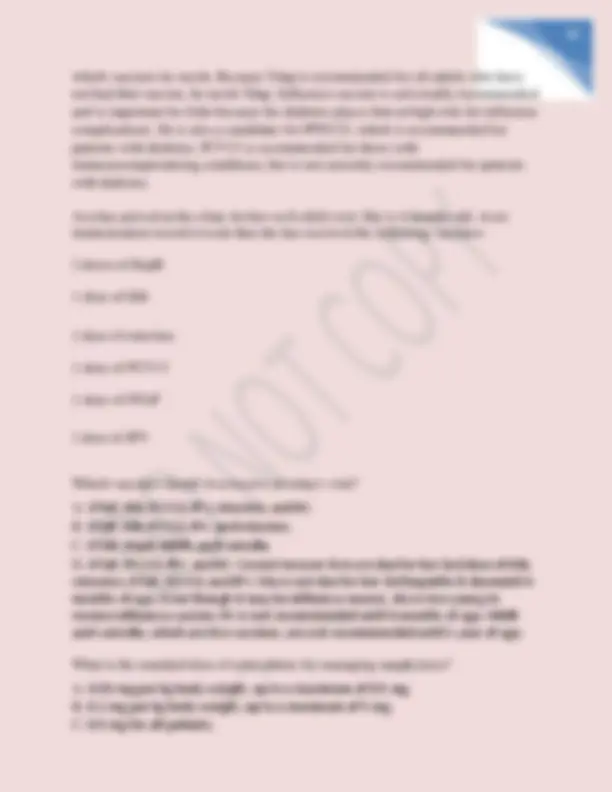

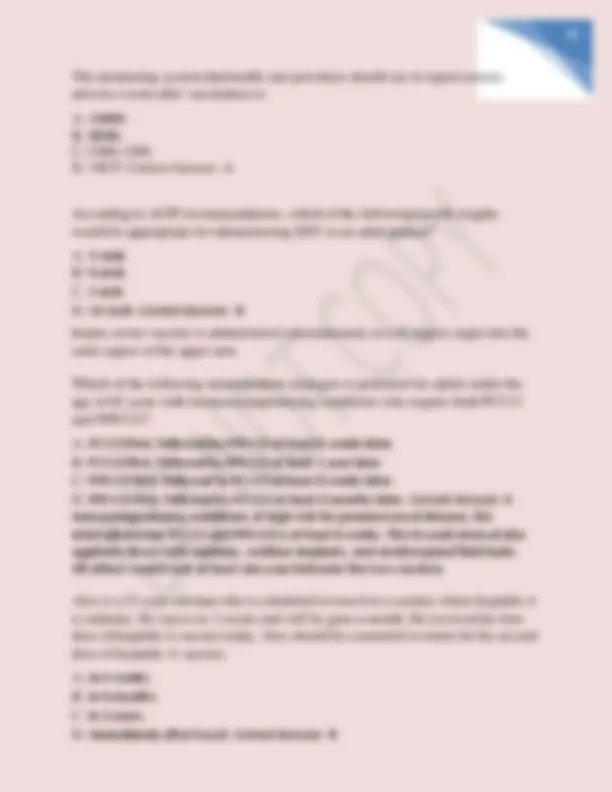

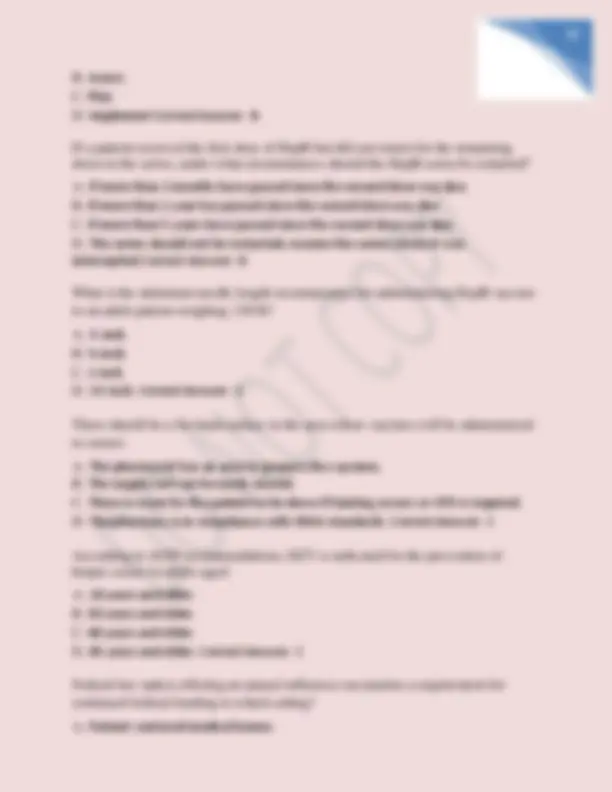

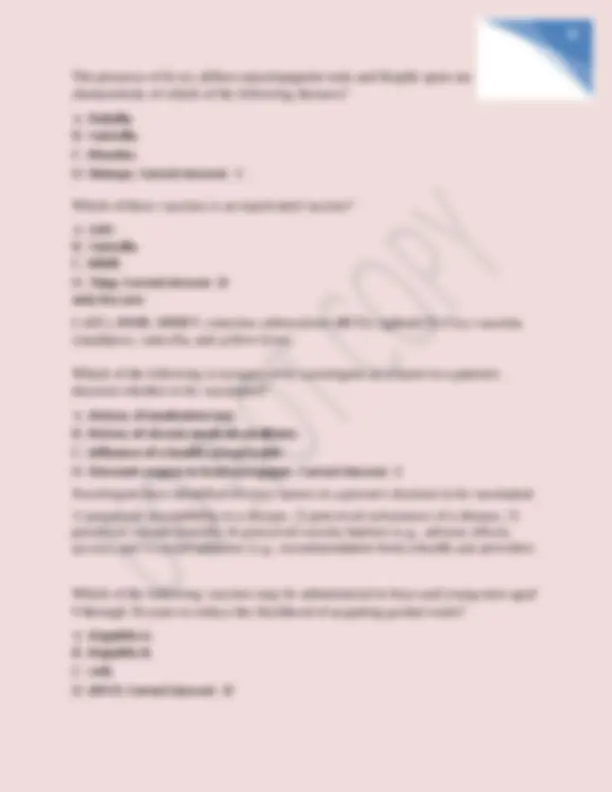

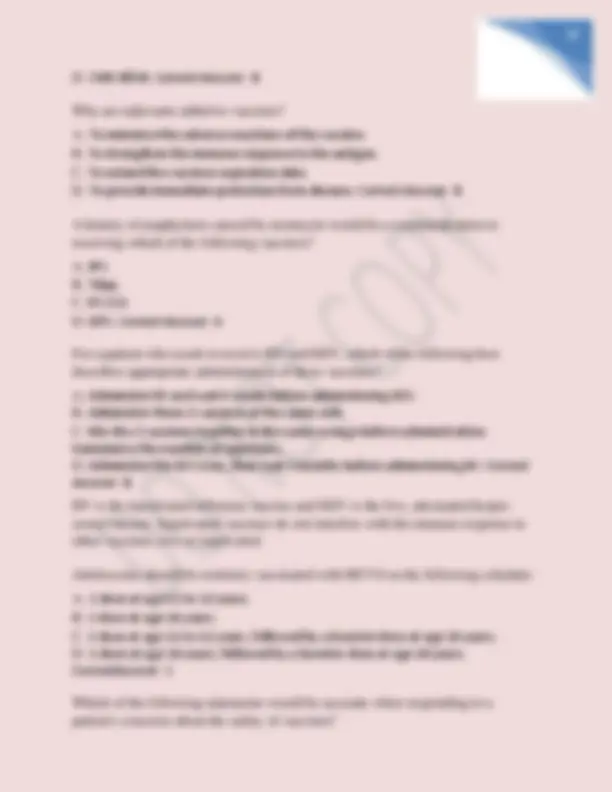

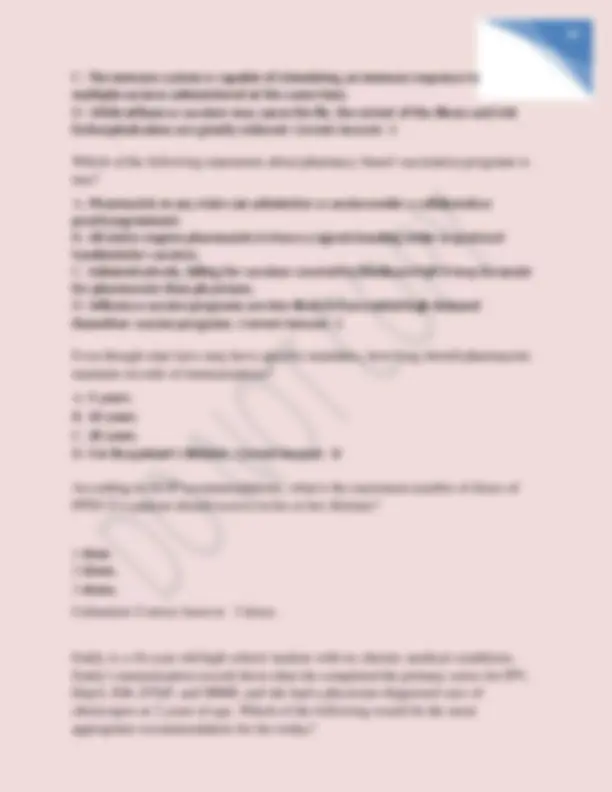

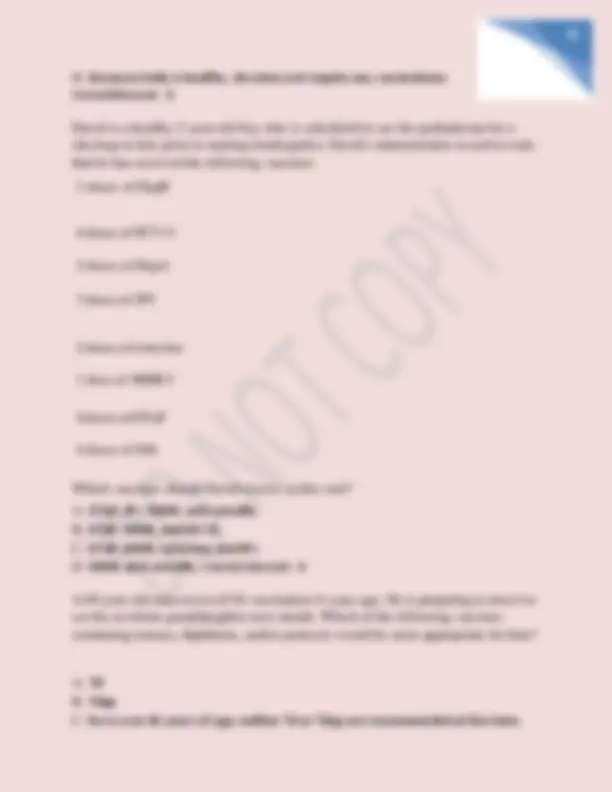

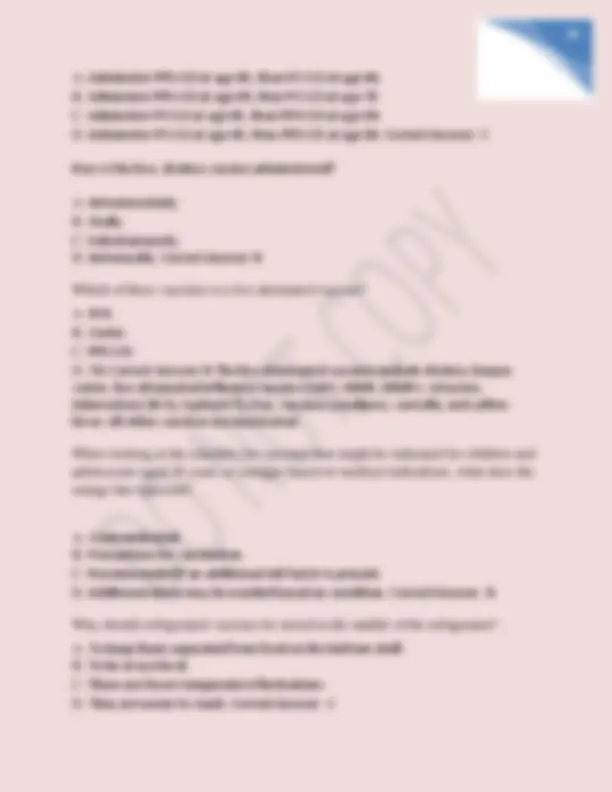

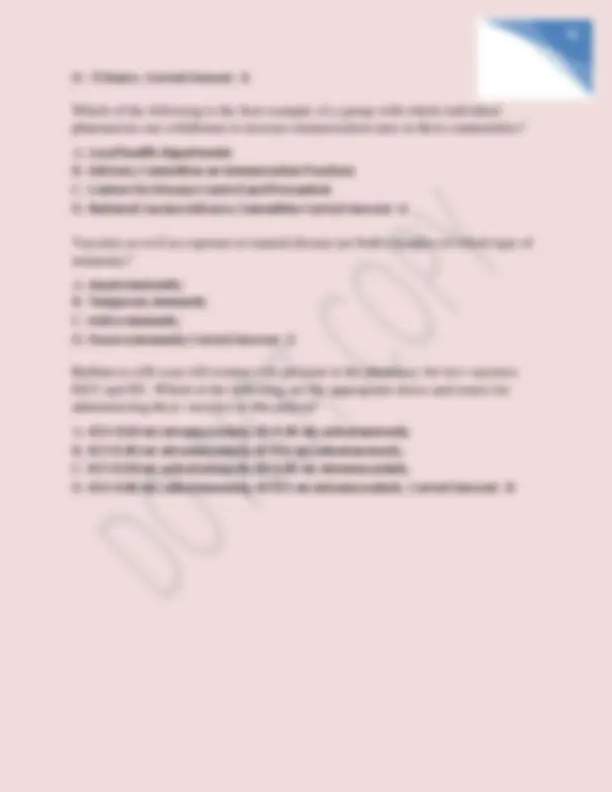


Study with the several resources on Docsity

Earn points by helping other students or get them with a premium plan


Prepare for your exams
Study with the several resources on Docsity

Earn points to download
Earn points by helping other students or get them with a premium plan
Community
Ask the community for help and clear up your study doubts
Discover the best universities in your country according to Docsity users
Free resources
Download our free guides on studying techniques, anxiety management strategies, and thesis advice from Docsity tutors
A comprehensive self-study assessment on immunization, covering key questions and correct answers related to vaccine administration, disease prevention, and safety protocols. It addresses topics such as vaccine types, contraindications, and special populations, offering valuable insights for healthcare professionals and students in pharmacy and medicine. The assessment includes questions on influenza, pertussis, hepatitis b, and other vaccine-preventable diseases, along with guidelines for vaccine storage, handling, and administration techniques. It serves as a practical resource for enhancing knowledge and competence in immunization practices, ensuring safe and effective vaccination strategies. Useful for university students, lifelong learners and high school students.
Typology: Exams
1 / 40

This page cannot be seen from the preview
Don't miss anything!

































Which of the following key questions is important to ask a patient before administering IIV?
A. Are you sick today? B. During the past year, have you received a blood transfusion or immune (gamma)globulin? C. Have you received any vaccinations in the past 4 weeks? D. Do you have cancer, leukemia, AIDS, or any other immune system problem? Correct Answer: A
What is the most common complication of pertussis? Correct Answer: pneumonia
Which disease is characterized by the development of a membrane on the tonsils, pharynx, or larynx, leading to respiratory obstruction?
A. Pertussis. B. Diphtheria.
C. Haemophilus influenzae type b.
D. Meningitis. Correct Answer: B
At what point during pregnancy is it recommended to administer the influenza vaccine?
A. Anytime is safe B. During the 1st trimester
C. 27 to 36 weeks
D. Wait until after the baby is delivered Correct Answer: A
Influenza vaccination during pregnancy not only decreases the risks for influenza- related complications during pregnancy, but has also been shown to reduce influenza-related hospitalizations in newborns.
Which of the following best describes how to administer Tdap vaccine to an adult patient weighing 185 lb?
A. Inject subcutaneously at a 45° angle in the outer aspect of the upper arm.
B. Inject intramuscularly at a 45° angle in the deltoid muscle.
If pharmacists are called upon to assist with vaccination efforts following a natural disaster, which vaccine is likely to be needed by many of the victims?
A. Tetanus B. Pneumococcal
C. MMR
D. Meningococcal B Correct Answer: A
Upon giving a VIS to a patient who is to receive a vaccine cover under the National Childhood Vaccine Injury Act, what must be documented?
A. The date the VIS was given to the patient or caregiver and the title of the VIS. B. The date printed on the VIS and signed confirmation that the patient has readthe VIS. C. The date the VIS was given to the patient or caregiver and the date printed onthe VIS. D. Signed confirmation that the patient has read the VIS and the title of the VIS.Correct Answer: C
A health care provider who has not been vaccinated against hepatitis B is stuck by a contaminated needle after administering an immunization to a hepatitis B- positive patient. In addition to hepatitis B vaccine, the health care provider also should receive hepatitis B Immunoglobulin (HBIG) as postexposure prophylaxis because the HBIG provides:
A. Long-term protection
B. Both short- and long-term protection
C. A booster effect for the vaccine
D. Prompt immunity Correct Answer: D
Which of the following best describes an opportunity for pharmacists to use diagnosis-based screening to identify people at risk for vaccine-preventable diseases?
A. Performing a medication review for a patient who has diabetes. B. Recommending vaccinations for a patient undergoing a splenectomy.
C. Providing hospital discharge counseling to a patient.
D. Providing vaccine information at a booth of a health fair. Correct Answer: A
Herd immunity refers to which of the following situations?
A. Vaccination of enough individuals in a community to protect those who cannotbe vaccinated. B. Immunity that occurs following infection with wild-type virus. C. Vaccinating groups of individuals who are at high risk for disease from environmental microbes. D. Immunity from diseases that circulate in other species. Correct Answer: A
Which of the following is a requirement of the Occupational Safety and Health Administration's (OSHA's) Bloodborne Pathogens Standard?
A. All persons employed by the pharmacy must be offered hepatitis A and hepatitisB vaccines. B. Health care providers must use safety devices when administering injectablevaccines. C. All needles should be clipped or recapped before placing in the biohazardcontainer. D. All employees of the pharmacy must attend an OSHA training course every 5 years. Correct Answer: B
Which type of vaccine involves stimulation of B cells without the assistance of T helper cells?
A. Live attenuated vaccines B. Conjugated vaccines C. Pure polysaccharide vaccines
D. Recombinant vaccines Correct Answer: C
A pure polysaccharide vaccine does not require T-helper cells to produce an immune response. It is mediated solely through B cells. As such, they are T cell- independent.
Which disease is almost certain to cause death if infected patients do not receive postexposure prophylaxis?
A. Hepatitis B.
B. Measles. C. Meningococal disease.
D. Rabies. Correct Answer: D
The childhood/adolescent and adult immunization schedules are updated and published annually during which months?
A. January or February
B. April or May
C. September or October
D. November or December Correct Answer: A
Alan is a 47-year-old man who has no documentation of a primary series of tetanus-containing vaccine. Which of the following would be an appropriate primary series for Alan?
A. DTaP today; Td in 4 weeks; Td 6 months after the second dose.
C. Past history of herpes zoster.
D. Has never received the varicella zoster vaccine (VAR). Correct Answer: A
Justin is a healthy 16-year-old boy who has no documentation of varicella vaccine or history of the disease. He should receive:
A. No doses of varicella vaccine because he can be considered immune to varicella B. 1 dose of varicella vaccine.
C. 2 doses of varicella vaccine separated by at least 4 weeks. D. 2 doses of varicella vaccine separated by 3 months. Correct Answer: C
Which of the following statements is true regarding how vaccines evoke an immune response?
A. T cells bind directly to the antigen contained in the vaccine and activate thehumoral immune response. B. The antigen in the vaccine activates B cells, which produce antigen-specific antibodies and memory cells. C. When exposed to the vaccine, T cells mature into plasma cells and produceantigen-specific antibodies. D. B cells bind directly to the antigen contained in the vaccine and activate thecell-mediated immune response. Correct Answer: B
What is the time interval for which the development of Guillain-Barré syndrome following influenza vaccination would result in a precaution for future influenza vaccines?
A. Within 6 weeks
B. Within 6 months
C. Within a year
D. Within 5 years Correct Answer: A
Which of the following is most likely to result in an influenza pandemic?
A. Antigenic drift in an influenza A virus.
B. Antigenic shift in an influenza A virus.
C. Antigenic drift in an influenza B virus. D. Antigenic shift in an influenza C virus. Correct Answer: B
If a patient is a candidate for revaccination with PPSV23, what is the ACIP- recommended interval between doses of this vaccine? Correct Answer: 5 years
Which of the following patients is a candidate for both MenACWY and MenB vaccines?
D. A 22 year-old military recruit. Correct Answer: A
Which of the following vaccines is recommended for infants to receive within 24 hours of birth?
A. IIV3, if during influenza season. B. Hepatitis A.
C. Hepatitis B.
D. MMR Correct Answer: C
In which publication does the CDC initially publish new or updated vaccine recommendations?
A. Epidemiology and Prevention of Vaccine-Preventable Diseases B. Needle Tips
C. Morbidity and Mortality Weekly Report (MMWR)
D. Vaccine Correct Answer: C
Kimberly is a 34 year-old woman who is 30 weeks pregnant. She received a Td booster dose 1 year ago when she cut her hand while working in the kitchen. She has no documentation of receiving a Tdap vaccine. The most appropriate recommendation would be to administer:
A. Tdap as soon as possible.
B. Tdap immediately postpartum.
C. DTaP as soon as possible.
D. Td in 9 years. Correct Answer: A
Prior to the introduction of a vaccine, what was the leading cause of bacterial meningitis in children younger than 5 years of age?
A. Haemophilus influenzae type b.
B. Diphtheria.
C. Varicella. D. Streptococcus pneumoniae. Correct Answer: A
Which vaccine does ACIP recommend for all college freshmen, aged 21 years or younger, living in dormitories, who have not been previously vaccinated?
A. PPSV23. B. MCV4.
C. 9vHPV.
D. Varicella. Correct Answer: B
D. 10 years. Correct Answer: D
The incubation period for influenza can range from:
A. 1 to 4 days
B. 7 to 10 days
C. 2 to 3 weeks
D. 3 to 4 weeks Correct Answer: A
HZV should not be administered to a patient with a history of anaphylaxis to:
A. Eggs.
B. Latex.
C. Tree nuts.
D. Gelatin. Correct Answer: D
Kate is a 24-year-old woman with asthma. She requests a refill of her albuterol inhaler on November 1st. Kate's immunization record indicates that she completed the primary series of MMR, varicella, DTaP, HepA, and HepB vaccines, and she received a dose of Tdap 2 years ago. For complete coverage, which of the following vaccines should she receive?
A. PCV13 and IIV.
B. PPSV23, IIV, and HPV.
C. PPSV23, IIV, HPV, and Td.
D. IIV, HPV, and Td. Correct Answer: B
PPSV23 is recommended for those ages 19 through 64 years of age with asthma.
<27=HPV
What is meant by the term "immunization neighborhood"?
A. Pharmacists live in a community where the population has met Healthy People2020 immunization targets. B. A community has adequate access to vaccines.
C. Immunization stakeholders collaborate to meet community immunization needs. D. Patient-centered medical homes provide immunization services. CorrectAnswer: C
HealthMap Vaccine Finder is a free online tool that allows pharmacists to:
A. Order vaccines from multiple distributors through a centralized hub. B. Manage vaccine inventory during shortages.
C. List their vaccination services so patients can find them when searching thewebsite for nearby immunizers.
C. 12-year-old boy.
D. 8-year-old girl. Correct Answer: C
Arthus reactions, which are exaggerated local reactions that can occur if a patient is vaccinated too frequently, are most commonly reported after which vaccine?
A. Inactivated influenza vaccine (IIV). B. Tetanus and diphtheria toxoid-containing vaccines.
C. Pneumococcal polysaccharide vaccine (PPSV).
D. Hepatitis B vaccine. Correct Answer: B
RotaTeq (RV5) should be administered as a:
A. 2-dose series to infants at 2 and 4 months of age.
B. 2-dose series to infants at 0 and 6 months of age.
C. 3-dose series to infants at 2, 4, and 6 months of age.
D. 3-dose series to infants at 1, 2, and 6 months of age. Correct Answer: C
Kyle is a 5-year-old boy who is up to date with his vaccinations. He has never experienced any adverse effects from vaccinations. At his next well-child check- up, Kyle will be receiving the following vaccines: IPV, MMR, varicella vaccine, and a tetanus-containing vaccine. Which of the following tetanus-containing vaccines would be appropriate for him?
A. DTaP.
B. DT.
C. Td. D. Tdap. Correct Answer: A DTaP is a five-dose series given at ages 2, 4, 6, 15 through 18 months, and 4 through 6 years. Kyle is due for his 5th and final dose ofDTaP. DTaP is appropriate for children less than 7 years of age. DT is only reserved for children who have a contraindication to the pertussis component in DTaP. Children, adolescents, and adults 7 years of age and older who require protection against tetanus, diphtheria, and pertussis would receive Tdap. Followingthe one-time dose of Tdap, a Td booster should be given every 10 years.
Which viruses are associated with the development of cancer?
A. Human papillomavirus and hepatitis B virus.
B. Varicella virus and hepatitis A virus.
C. Hepatitis A and herpes zoster.
D. Rubella and varicella virus. Correct Answer: A
With the exception of rotavirus, the routinely recommended live vaccines are contraindicated in a patient who: